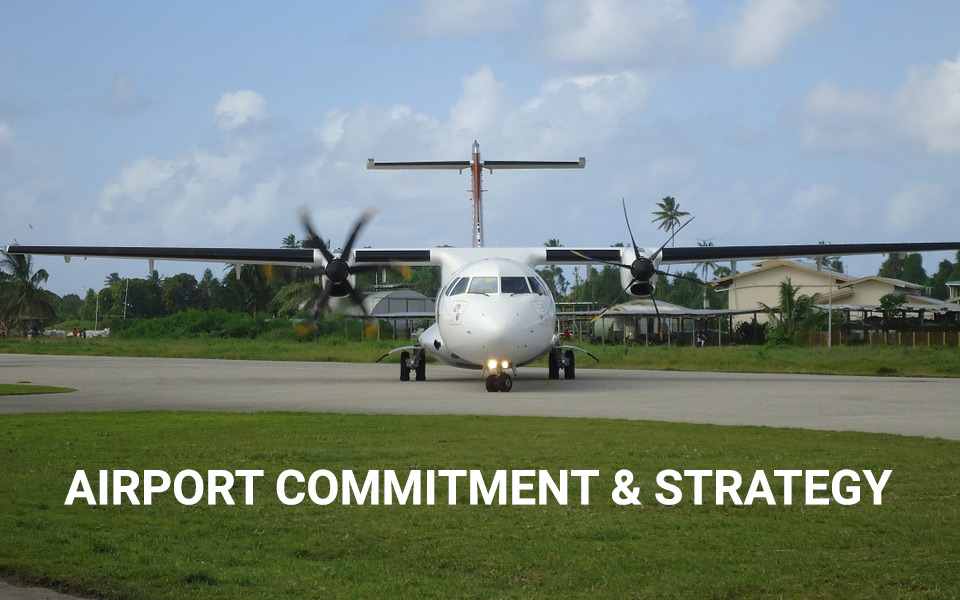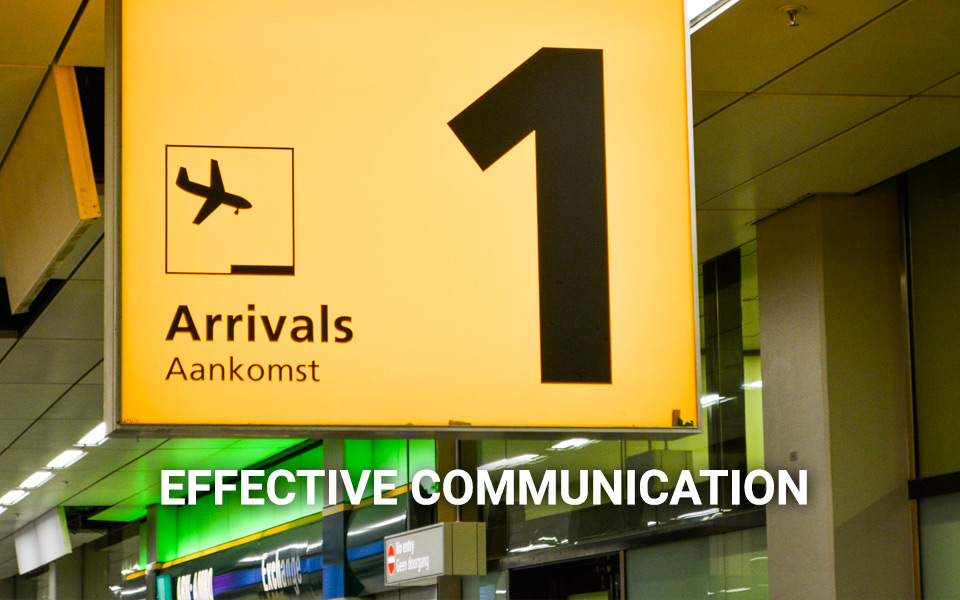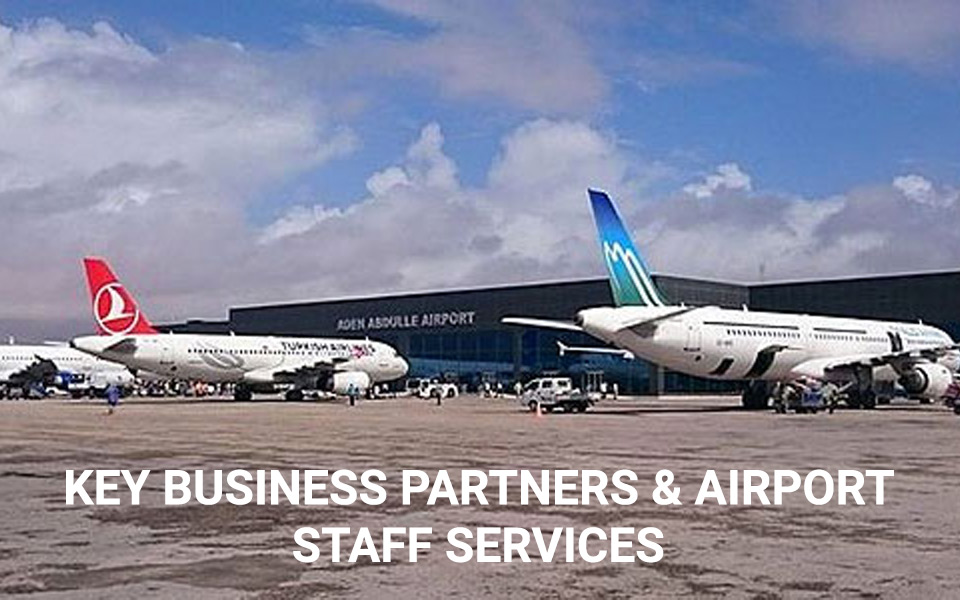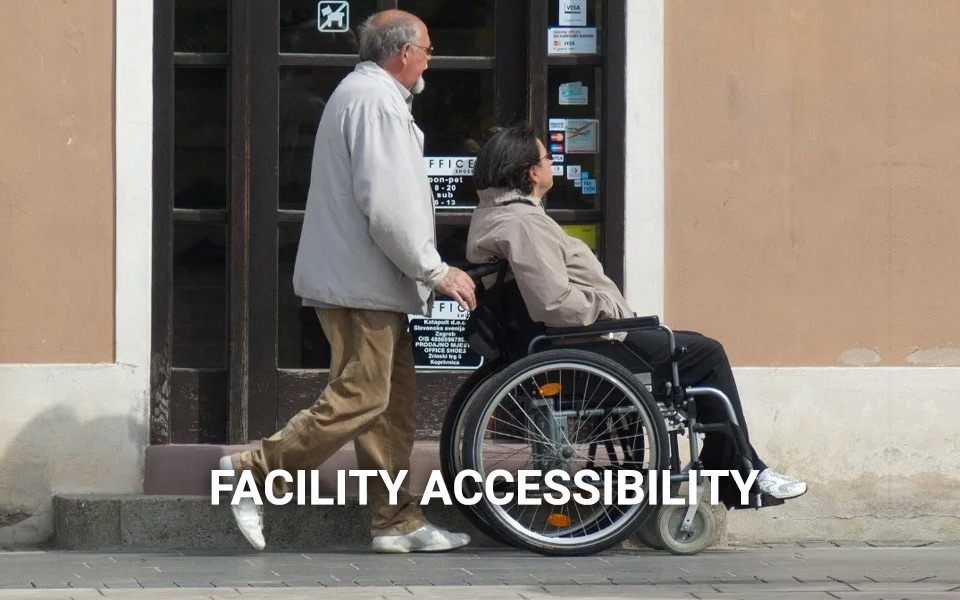A Companion WebResource to ACRP Research Report 239:
Assessing Airport Programs for Travelers with Disabilities and Older Adults
Facility Accessibility
Facility accessibility is a basic right that all travelers should have when engaging in their journeys through airports. While the Americans with Disabilities Act (ADA) mandates certain requirements, airport facilities are still not as accessible as they need to be to accommodate travelers with disabilities and older adults. The issue is further exacerbated because many airport terminals were designed and retrofitted long ago and did not consider as many traveler comforts and needs as architects and designers do today. Another key issue is that travelers do not know who is responsible for assisting them when entering facilities and drop-off points such as parking lots, rental cars, curbside or the terminal.
1. Access of Arrival (Curbside, Parking or Other Drop-Off Point)
While there are multiple transportation options, the arrival points for travelers with disabilities and older adults may be limited due to several factors noted in ACRP Research Report 210: Innovative Solutions to Facilitate Accessibility for Airport Travelers with Disabilities, including:
- Accessibility of the available modes of transportation;
- Location of airport arrival point (curbside or remote);
- If remote, distance to walk and/or accessibility of shuttle or automated people mover;
- Availability of disability-related assistance and means to request it at the arrival point; and
- Availability of assistance with luggage.
The following notable practices improve access of arrival at the airport for the target groups.
1.1 Accessible ground transportation (rideshare, taxis, hotel shuttles, etc.)
- Designate accessible loading zones on arrivals and departures levels adjacent to curb cuts. Identify zones with clearly visible signage and roadway markings.
- Communicate the designated area by signage. Mark the location on the airport layout map on the website and airport app.
- Provide a contact number on signage and online that can be called or texted, kiosks, or courtesy phones to request assistance at each major airport arrival point.
1.2 Designate pick-up/drop-off areas for travelers needing assistance
- Train assistants to let travelers know how long they can expect to wait when left unattended and how to request assistance if they require it.
- Provide a contact phone number with voice and text messaging capabilities for travelers who are unable to move about independently and need to request immediate assistance.
- Provide a customer-facing app similar to those used by transportation network companies that shows the expected arrival time of the assigned assistant and offers a means to communicate as needed.
- Provide self-service/autonomous wheelchairs or scooters in airports to offer more flexibility and independence for travelers.
- Set key performance indicators in conjunction with airlines and their service companies, and require them to regularly provide data to assess their performance.
1.3 Provide travelers with the means to request assistance on arrival
- Provide digital or physical means to request assistance (accessible kiosk, courtesy phones, phone/text number, call button, etc.) in parking facilities/lots, public transportation, and other drop-off areas, and publicize availability of the service on the website and through social media.
- Provide assistance in areas not covered by the Air Carrier Access Act (ACAA) Part 382 (rental car facilities, parking facilities, light rail, etc.).
- Encourage airlines and their service providers to create and staff reception areas near terminal entrances where curbside check-in is not available. This is especially helpful at international terminals where curbside check-in is not available.
- Provide the means of requesting timely assistance at point of arrival (and at point of departure).
- Provide a free, accessible mode of transport (accessible shuttle, electric cart, wheelchair service, etc.) between terminals and between remote areas (such as parking garage, rental car lot, etc.) and the terminal.
- The airport can choose to manage service provision to cover the gap themselves.
- Airports, airlines and third-party providers need to collaborate on determining the best way to share information about the traveler requesting assistance. This may include providing the contact phone numbers for the airport to request assistance on arrival on the website.
2. Terminal Layout and Design
Given changing accessibility needs and an upcoming change to ADA Accessibility Standards for design, airports are encouraged to adopt a more universal, inclusive approach to terminal and facility design, which can include architecture, sounds and changes in gradient or texture of flooring. Universal Design (UD), as the name suggests, attempts to meet the needs of people of all ages, sizes and abilities. According to the Universal Design Society, UD is “an approach to design that works to ensure products and buildings can be used by virtually everyone, regardless of their level of ability or disability.” Some notable practices to improve terminal layout and design for travelers with disabilities and older adults include:
- Review the lighting throughout the terminal to ensure adequate and safe lighting and minimize glare.
- Identify and minimize unpleasant sensory experiences (sounds, lighting, etc.).
- Create a Design Standards manual in collaboration with internal stakeholders and travelers with disabilities, and provide it to concessionaires, vendors and contractors.
3. Equipment Accessibility
Ensuring access to certain equipment for travelers with disabilities and older adults can help create a safer, more convenient and more comfortable experience for these groups. The following notable practices relate to equipment accessibility.
3.1 Common use self-service kiosks
Kiosks installed on or after December 12, 2016, must meet the design specifications set by Part 382 and Section 504, with a minimum of 25 percent accessible by December 12, 2022:
- Clearly identify accessible kiosks and standardize their location.
- Enable/direct customers who cannot use kiosks due to their disability to go to the head of the full-service line, as required by the ACAA, or provide a dedicated line for customers with disabilities.
- Ensure staff are present to direct and assist customers, as required by the ACAA.
- Implement touchless check-in options.
- Provide voice-activated kiosks (when legally permissible).
- Review regulatory requirements under the ACAA and Section 504.
- Review industry notable practices.
3.2 Seating
- Provide a row of seats in the ticket counter area, near the entry to the security checkpoint and at frequent intervals along long concourses.
- Provide a row of seats with armrests in each security re-composure area for older travelers and those with reduced mobility, not just low benches without backs or armrests.
- Plan for additional seating throughout the terminal in any renovations or new terminal designs.
- Ensure that seating designs meet accessibility needs, such as higher seats with armrests that enable older travelers to more easily sit and stand, and seats with no exterior armrest to enable transfer by persons using their own wheelchairs.
- Provide charging stations for devices near seating.
3.3 Amenities
As renovations and/or new terminals/concourses are designed, the viewpoint of the traveler must be taken into consideration, with attention to the need for sensory rooms or quiet areas, lighting and glare adjustments, additional wheelchair storage at locations throughout the airport, provision of electric carts that can transport multiple customers with reduced mobility, new technologies such as automated wheelchairs, etc. Notable practices to ensure adequate amenities are provided include:
- Provide a sensory room or quiet area within each concourse. Create an area identified as a “quiet” area for immediate relief if no sensory room can be available.
- Locate a small area in each concourse where a portable Service Animal Relief Area can be installed (as at Philadelphia International Airport and Charlotte Douglas International Airport) until a more permanent solution can be designed and built.
- Meet with organizations representing travelers with hidden disabilities, such as autism, to determine the need and use of sensory rooms and/or quiet areas and their effectiveness.
- Provide clearly identified adult and/or private changing rooms pre-security and beyond security on concourses.
- Provide adequate adult-sized, height-adjustable changing tables. These should be clearly identified and located landside and airside in each terminal.
- Identify the demand for change machines and provide at least one change machine pre-security in a strategic location, such as a baggage claim.
- Offer a wheelchair, stroller and scooter rental program to provide travelers with disabilities and older adults with more autonomy.
MINI CASE STUDY: VANCOUVER INTERNATIONAL AIRPORT ACCESSIBILITY
Example of commitment to facility accessibility through Universal Design
Region: Canada

Vancouver International Airport (YVR) has been a proponent of Universal Design (UD) for over 20 years, incorporating UD standards into new construction and improvements to existing facilities and services since the airport was built in 1995. YVR has historically exceeded code minimums for supporting passenger wayfinding with the intent to help passengers orient themselves intuitively with minimal reliance on signage. This is in addition to a terminal layout that minimizes walking distances along with a UD approach to lighting, millwork, flooring and other finishes. A detailed list of the accessibility and UD features at YVR can be found in Chapter 11 in ACRP Research Report 210.
Recognizing the airport’s commitment to accessibility, the Rick Hansen Foundation (RHF) in 2018 awarded YVR with the first Accessibility Certified Gold rating, the highest rating in the Rick Hansen Foundation Accessibility Certification Program (RHFAC). The RHFAC is the first program to measure the level of meaningful access beyond building code and is based upon the holistic user experience of people with varying disabilities affecting their mobility, vision and hearing. As of 2021, over 1,350 sites have been rated by the RHF.
A number of accessibility features were identified as leading to YVR’s Gold rating including:
- Universal food and service counters for people using wheeled mobility devices
- Low-resistance carpeting for easier movement and greater stability
- Textured terminal flooring to assist with wayfinding
- Curbside ramps and assistance
- Accessible parking in all lots with accessible bus service to long-term parking
- Universal seating throughout the terminal
- Universally accessible washrooms
- Pet relief areas for individuals traveling with assistance animals
- Adaptive speakers throughout the terminal building
- Clearly marked signage and wayfinding
This toolbar provides a key for the assessment tool icons. Click on each icon for more details



